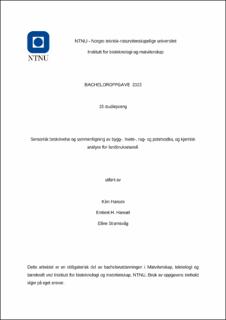| dc.contributor.advisor | Wahlgren, Marte Berg | |
| dc.contributor.advisor | Waldenstrøm, Lene | |
| dc.contributor.author | Hansen, Kim | |
| dc.contributor.author | Hansæl, Embret Hermann | |
| dc.contributor.author | Strømsvåg, Eline | |
| dc.date.accessioned | 2023-07-01T17:23:06Z | |
| dc.date.available | 2023-07-01T17:23:06Z | |
| dc.date.issued | 2023 | |
| dc.identifier | no.ntnu:inspera:140792035:149018796 | |
| dc.identifier.uri | https://hdl.handle.net/11250/3075215 | |
| dc.description.abstract | Etter produksjonsmonopolet på brennevin ble opphevet, har det blomstret opp med håndverksdestillerier i Norge. Dette har medført et økende sortiment av norsk produsert brennevin på Vinmonopolet. For å undersøke om et produkt er attraktivt på markedet kan det benyttes sensoriske analyser.
Målet med denne oppgaven var å sensorisk beskrive lokaldestillerte vodka av bygg, hvete og rug, og undersøke forbrukeraksepten til disse, sammen med en referanse destillert på potet. Dette ved utførelse av en forbrukerundersøkelse med 109 deltakere i form av CATA med Aksepttest. Til forarbeidet av denne ble det valgt ut 38 termer som menes å være produktbeskrivende. Det ble utformet et spørreskjema, i EyeQuestion® til bruk under undersøkelsen, som ble utført på NTNU Kalvskinnet.
De lokaldestillerte vodkaene ble undersøkt med gasskromatografi, for om det var mulig å kategorisere de som Landbruksetanol.
Forbrukerpanelet fant ingen signifikant forskjell mellom vodkaene i aksept, hvor høyeste score var 4,73 og laveste 4,38. Forbrukergrupperingen ≤29 år viste signifikant høyere aksept for hvetevodka enn byggvodka. Etter utført CATA ble det funnet signifikant forskjell (p≤0,10) mellom vodkaene i 5 av de totalt 38 termene. Her viste det seg at kvinnelige deltakere finner flere forskjeller mellom vodkaene enn mannlige. Det ble videre funnet at vodkaene produsert av bygg, hvete og rug er mere ulike potetvodkaen, enn hverandre.
Ved en sammenligning av CATA og Aksepttest ble det funnet at noen termer påvirker akseptscoren i samme retning, for alle vodkaene.
Fra den kjemiske analysen kan det ikke avgjøres om vodkaene kan klassifiseres som Landbruksetanol. Dette fordi kolonnen som ble benyttet under utføring ikke ga stor nok forskjell i retensjonstid på etanol og isopropanol, til å kunne skille disse. | |
| dc.description.abstract | After the distilling monopoly was abolished, craft distilleries have flourished in Norway. This has led to an increasing range of Norwegian-produced spirits at Vinmonopolet. To investigate whether a product is attractive for the market, can sensory analyses be utilized.
The aim of this thesis was to sensory describe locally distilled vodka from barley, wheat and rye, and to investigate the consumer acceptance of these, together with a reference distilled on potato. This by carrying out a consumer survey with 109 participants in the form of CATA with Acceptance Test. For the preparation of this, 38 attributes were selected which are believed to be product descriptive. A questionnaire was designed in EyeQuestion® for use during the survey, which was carried out at NTNU Kalvskinnet.
The locally distilled vodkas were examined with gas chromatography, to see if it was possible to categorize them as ethyl alcohol of agricultural origin.
The consumer panel found no significant difference between the vodkas in terms of acceptance, with the highest score being 4,73 and the lowest 4,38. The consumer group ≤29 years old, showed significantly higher acceptance of wheat vodka than barley vodka. After carrying out CATA, a significant difference (p≤0.10) was found between the vodkas in 5 of the total 38 attributes. Here, it turned out that the female participants find more differences between the vodkas the male participants. It was further found that the vodkas produced from barley, wheat and rye are more different from potato vodka than from each other.
In a comparison of CATA and Acceptance Test, it was found that some attributes affect the acceptance score in the same direction, for all the vodkas.
From the chemical analysis, it cannot be determined whether the vodkas can be classified as ethyl alcohol of agricultural origin. Because the column used during execution did not separate compounds to determine difference in retention time for ethanol and isopropanol. | |
| dc.language | nob | |
| dc.publisher | NTNU | |
| dc.title | Sensorisk beskrivelse og sammenligning av bygg-, hvete-, rug- og potetvodka, og kjemisk analyse for landbruksetanol | |
| dc.type | Bachelor thesis | |
